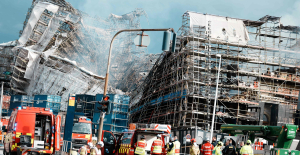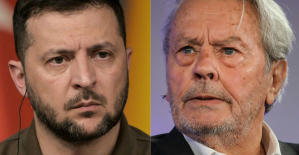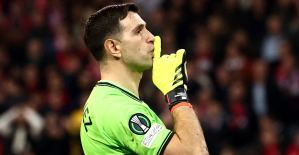Many collectors still have an unbroken love for Alfons Walde's harsh mountain and farm idylls, not to mention the skiers weaving over steep slopes. The creative zeal of the trained painter and architect was also unbroken. Born in Tyrol in 1891, he spent almost his entire life in Kitzbühel.
He designed the station building for the local Hahnenkammbahn and built his mountain house, in which there were lots and lots of celebrations. Walde created the logo that is still valid today for the naturally sedate and cozy winter sports domain, which was still aspiring at the time. Shooting and bubbly came later.
Walde painted the peasants on their way to church, stepping firmly, child and skittle in tow. He painted the farmsteads crouched in the mountain, modeling the play of glistening white snow and dark shadows on the mountain slopes and in the rugged rock with a swift, broad brush. Above, the sky always shines in a radically bright blue. He was a virtuoso of the secessionist and expressionist schooled winter landscape with a barren appearance.
Alfons Walde soon made a name for himself, marketing his motifs on postcards and posters. His second favorite (or maybe his favorite) subject was the female nude. Here, too, his creative power seemed inexhaustible, albeit with less popular results.
Although Walde paintings are by no means rare - the artist worked quickly, he repeated some of his popular Alpine depictions with slight variations - today they are often traded in the high six-figure price range. Last but not least, this may be due to the fact that at least one Alfons Walde is indispensable for furnishing a representative Tyrolean, especially Kitzbühel holiday chalet. And because he was able to reproduce snow and sky so atmospherically and characteristically like no other painter.
The photo biography of the “Kirchenstiege”, which will be called up at the Vienna auction house Dorotheum on November 29, 2022 (estimate price 120,000 to 200,000 euros), shows how strong the attraction could also have an effect on people with an appreciation for art who lived elsewhere. Franz Stiassny and his wife Käte emigrated from Silesia to Palestine in 1933. The national economist, born in Brno in 1901, had previously managed one of the largest German textile factories with 1,500 employees and refused to replace Jewish workers with "Aryan" workers. The young couple could not take money or valuables with them.
But the forest came with me. As an unemployed graduate, Stiassny had to reorganize his life - and became a dairy and vegetable farmer. A hard cut, but the right decision. His sister and her husband Desider Friedmann, then head of the Jewish community in Vienna, could not bring themselves to leave the city. And were killed in Auschwitz.
The “Kirchenstiege”, owned by the son of Franz Stiassny, a university professor of biochemistry, for 27 years, has finally fulfilled its hidden role as a comforting bridge to the lost home, which was intended with a certain sense of exoticism. The coast of the Levantine Sea is a thing of the past.

 Sydney: Assyrian bishop stabbed, conservative TikToker outspoken on Islam
Sydney: Assyrian bishop stabbed, conservative TikToker outspoken on Islam Torrential rains in Dubai: “The event is so intense that we cannot find analogues in our databases”
Torrential rains in Dubai: “The event is so intense that we cannot find analogues in our databases” Rishi Sunak wants a tobacco-free UK
Rishi Sunak wants a tobacco-free UK In Africa, the number of millionaires will boom over the next ten years
In Africa, the number of millionaires will boom over the next ten years WHO concerned about spread of H5N1 avian flu to new species, including humans
WHO concerned about spread of H5N1 avian flu to new species, including humans New generation mosquito nets prove much more effective against malaria
New generation mosquito nets prove much more effective against malaria Covid-19: everything you need to know about the new vaccination campaign which is starting
Covid-19: everything you need to know about the new vaccination campaign which is starting The best laptops of the moment boast artificial intelligence
The best laptops of the moment boast artificial intelligence Bitcoin halving: what will the planned reduction in emissions from the queen of cryptos change?
Bitcoin halving: what will the planned reduction in emissions from the queen of cryptos change? The Flink home shopping delivery platform will be liquidated in France
The Flink home shopping delivery platform will be liquidated in France Bercy threatens to veto the sale of Biogaran (Servier) to an Indian industrialist
Bercy threatens to veto the sale of Biogaran (Servier) to an Indian industrialist Switch or signaling breakdown, operating incident or catenaries... Do you speak the language of RATP and SNCF?
Switch or signaling breakdown, operating incident or catenaries... Do you speak the language of RATP and SNCF? The main facade of the old Copenhagen Stock Exchange collapsed, two days after the fire started
The main facade of the old Copenhagen Stock Exchange collapsed, two days after the fire started Alain Delon decorated by Ukraine for his support in the conflict against Russia
Alain Delon decorated by Ukraine for his support in the conflict against Russia Who’s Who launches the first edition of its literary prize
Who’s Who launches the first edition of its literary prize Sylvain Amic appointed to the Musée d’Orsay to replace Christophe Leribault
Sylvain Amic appointed to the Musée d’Orsay to replace Christophe Leribault Skoda Kodiaq 2024: a 'beast' plug-in hybrid SUV
Skoda Kodiaq 2024: a 'beast' plug-in hybrid SUV Tesla launches a new Model Y with 600 km of autonomy at a "more accessible price"
Tesla launches a new Model Y with 600 km of autonomy at a "more accessible price" The 10 best-selling cars in March 2024 in Spain: sales fall due to Easter
The 10 best-selling cars in March 2024 in Spain: sales fall due to Easter A private jet company buys more than 100 flying cars
A private jet company buys more than 100 flying cars This is how housing prices have changed in Spain in the last decade
This is how housing prices have changed in Spain in the last decade The home mortgage firm drops 10% in January and interest soars to 3.46%
The home mortgage firm drops 10% in January and interest soars to 3.46% The jewel of the Rocío de Nagüeles urbanization: a dream villa in Marbella
The jewel of the Rocío de Nagüeles urbanization: a dream villa in Marbella Rental prices grow by 7.3% in February: where does it go up and where does it go down?
Rental prices grow by 7.3% in February: where does it go up and where does it go down? With the promise of a “real burst of authority”, Gabriel Attal provokes the ire of the opposition
With the promise of a “real burst of authority”, Gabriel Attal provokes the ire of the opposition Europeans: the schedule of debates to follow between now and June 9
Europeans: the schedule of debates to follow between now and June 9 Europeans: “In France, there is a left and there is a right,” assures Bellamy
Europeans: “In France, there is a left and there is a right,” assures Bellamy During the night of the economy, the right points out the budgetary flaws of the macronie
During the night of the economy, the right points out the budgetary flaws of the macronie These French cities that will boycott the World Cup in Qatar
These French cities that will boycott the World Cup in Qatar Europa Conference League: the semi-final flies to Lille, which loses to the wire against Aston Villa
Europa Conference League: the semi-final flies to Lille, which loses to the wire against Aston Villa Lille-Aston Villa: Cash disgusts Lille, the arbitration too... The tops and the flops
Lille-Aston Villa: Cash disgusts Lille, the arbitration too... The tops and the flops Handball: Les Bleues in the same group as Spain at Euro 2024
Handball: Les Bleues in the same group as Spain at Euro 2024 Europa Conference League: for Létang, Martinez “does not have the attitude of a high-level athlete”
Europa Conference League: for Létang, Martinez “does not have the attitude of a high-level athlete”


















